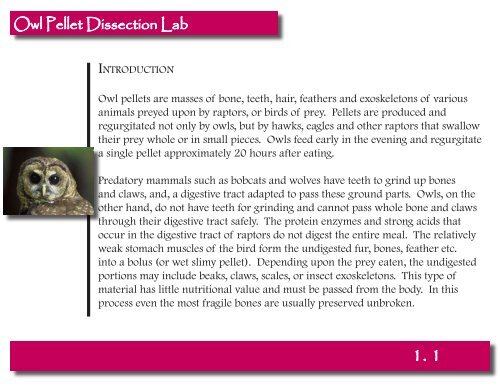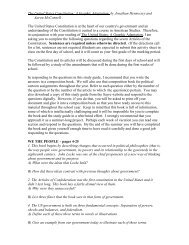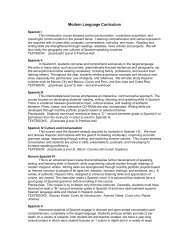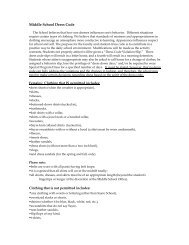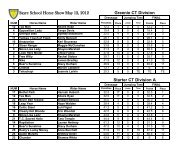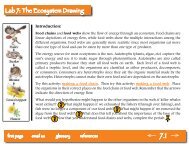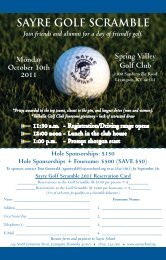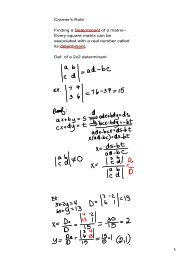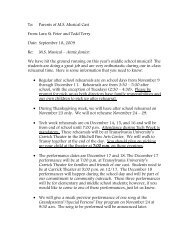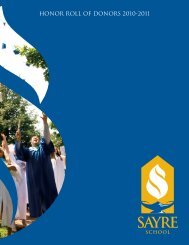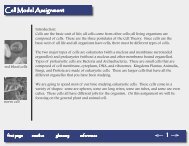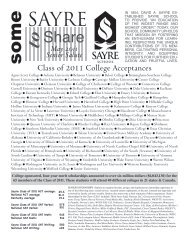Owl Pellet Dissection Lab
Owl Pellet Dissection Lab
Owl Pellet Dissection Lab
Create successful ePaper yourself
Turn your PDF publications into a flip-book with our unique Google optimized e-Paper software.
<strong>Owl</strong> <strong>Pellet</strong> <strong>Dissection</strong> <strong>Lab</strong><br />
Introduction<br />
<strong>Owl</strong> pellets are masses of bone, teeth, hair, feathers and exoskeletons of various<br />
animals preyed upon by raptors, or birds of prey. <strong>Pellet</strong>s are produced and<br />
regurgitated not only by owls, but by hawks, eagles and other raptors that swallow<br />
their prey whole or in small pieces. <strong>Owl</strong>s feed early in the evening and regurgitate<br />
a single pellet approximately 20 hours after eating.<br />
Predatory mammals such as bobcats and wolves have teeth to grind up bones<br />
and claws, and, a digestive tract adapted to pass these ground parts. <strong>Owl</strong>s, on the<br />
other hand, do not have teeth for grinding and cannot pass whole bone and claws<br />
through their digestive tract safely. The protein enzymes and strong acids that<br />
occur in the digestive tract of raptors do not digest the entire meal. The relatively<br />
weak stomach muscles of the bird form the undigested fur, bones, feather etc.<br />
into a bolus (or wet slimy pellet). Depending upon the prey eaten, the undigested<br />
portions may include beaks, claws, scales, or insect exoskeletons. This type of<br />
material has little nutritional value and must be passed from the body. In this<br />
process even the most fragile bones are usually preserved unbroken.<br />
1.
<strong>Owl</strong> <strong>Pellet</strong> <strong>Dissection</strong> <strong>Lab</strong><br />
Scientists take advantage of this adaptation by collecting these pellets and<br />
examining their contents. Since owls are not very selective feeders, these pellets<br />
can be used to estimate the diversity of available prey. The contents are also a<br />
direct indicator of what an owl has fed on; information that is crucial for species<br />
management and protection.<br />
The owl pellets that you will be examining in this lab have been<br />
collected and fumigated from common barn owls (Tyto alba). <strong>Owl</strong><br />
pellets themselves are ecosystems, providing food and shelter for<br />
communities that may include clothes moths, carpet beetles and fungi.<br />
Clothes moth larvae are frequently abundant in pellets, feeding on fur<br />
and feathers. The black spheres about the size of periods (.) that are<br />
found in the pellets are the droppings of the caterpillars. The larvae<br />
metamorphose near the surface of a pellet in cocoons made of fur.<br />
1.
<strong>Owl</strong> <strong>Pellet</strong> <strong>Dissection</strong> <strong>Lab</strong><br />
Materials:<br />
• owl pellet (wrapped in aluminum foil)<br />
• brown glass specimen jar (cap optional)<br />
• dishwashing detergent or hand soap<br />
• cheese cloth<br />
• forceps<br />
• 2 dissecting mounts<br />
• dissecting probe<br />
• dissecting pan/tray (located at station)<br />
• several sheets of white paper (recycled)<br />
• 2 specimen dishes and/or watch glasses/petri dishes<br />
• metric balance<br />
• ruler<br />
• stereoscopic dissecting microscope<br />
• magnifying glass<br />
• water<br />
• paper towel<br />
• desiccating oven (high temp.)<br />
• latex gloves (pair for each partner)<br />
1.
<strong>Owl</strong> <strong>Pellet</strong> <strong>Dissection</strong> <strong>Lab</strong><br />
Procedure:<br />
1. Unwrap and examine the outside of the owl pellet. Put all data and observations<br />
on the Data, Observations, & Analysis page. Describe the external<br />
features. Measure and record its length and width in centimeters. Measure<br />
and record the owl pellet mass in grams.<br />
2. To investigate the interior of the pellet you must soften it by soaking it<br />
in water. Fill the specimen jar 3/4 full with tap water. Add a drop or two<br />
of dishwashing liquid or hand soap and the pellet to the jar. Close the<br />
jar with a cap or cover with your gloved hand and shake gently for about<br />
30 seconds. Let the jar stand for five minutes and shake again for 30<br />
seconds.<br />
3. When the pellet has fallen apart, have your partner hold the cheese cloth,<br />
and slowly pour the contents of the jar over the cheese cloth. Be careful<br />
not to allow any animal fragments, bone, or fur wash into the sink.<br />
1.
<strong>Owl</strong> <strong>Pellet</strong> <strong>Dissection</strong> <strong>Lab</strong><br />
4. Place the cheese cloth on a piece of white paper. Pick bones, teeth, insect<br />
parts, and any other prey evidence out of the fur and place all prey evidence<br />
(except skulls) in a specimen dish or watch glass. Place the skulls on a second<br />
sheet of paper. Use probes, dissecting mounts, or forceps, as necessary, but<br />
proceed carefully to avoid crushing any small bones. Separate the fur and<br />
other soft matter as you search for bones by placing them in a separate<br />
specimen dish or watch glass.<br />
5. <strong>Lab</strong>el the skulls by number, and use this dichotomous key to<br />
identify them. Record the species of each skull on your answer sheet.<br />
6. Try to match other bones to each skull. Use the preserved specimens<br />
and the diagrams of animal bone structures provided to identify each<br />
bone and record its name under its matching skull on your answer<br />
sheet.<br />
7. Use the links provided with the dichotomous key to find the likely habitat and<br />
diet of each species found in the pellet. Record the information on your answer<br />
sheet.<br />
1.
<strong>Owl</strong> <strong>Pellet</strong> <strong>Dissection</strong> <strong>Lab</strong><br />
8. Talk with other groups and find the types and number of species found in all of<br />
the pellets. Record this in Table 2.<br />
9. Once all bones have been identified, collect your bones in the specimen dish.<br />
Carefully dry as many as you can with one or two pieces of paper towel. Add<br />
the other organic matter (i.e. fur and small miscellaneous pieces). Then, make<br />
a small mark on your specimen dish to be able to identify it, and place your<br />
entire specimen dish in a high temperature oven for drying. Check the organic<br />
matter after 24 hours to record the biomass.<br />
10. Complete the Answer Sheet and make sure both team members<br />
have a copy.<br />
11. Complete the Homework for this lab.<br />
1.
<strong>Owl</strong> <strong>Pellet</strong> <strong>Dissection</strong> <strong>Lab</strong><br />
References<br />
“Alcorn/AP Environmental Science <strong>Owl</strong> <strong>Pellet</strong> <strong>Dissection</strong>.” Dr. Decino’s webpage.<br />
Carlsbad High School. 27 Oct. 2008 .<br />
Gautschi, D. Tobias. “<strong>Owl</strong> <strong>Pellet</strong> <strong>Lab</strong>.” Mr. Gautschi’s Home Page. El Dorado High<br />
School. 27 Oct. 2008. .<br />
Radcliffe, G. “HUMAN BODY <strong>Lab</strong> 3: <strong>Owl</strong> <strong>Pellet</strong> <strong>Dissection</strong>.” Human Body Unit.<br />
Centreville Middle School. 27 Oct. 2008 .<br />
1.
<strong>Owl</strong> <strong>Pellet</strong> <strong>Dissection</strong> <strong>Lab</strong><br />
Images<br />
Image:Shituan.jpg (<strong>Pellet</strong>s from a long eared owl)<br />
This file is licensed under the creative commons attribution sharealike 2.5 license. in short: you are free to<br />
share and make derivative works of the file under the conditions that you appropriately attribute it, and that<br />
you distribute it only under a license identical to this one. official license<br />
Barn owl images (both adult and chicks)<br />
florinorfolk. “Magic <strong>Owl</strong>s.” weblog post. photorama . 29 may 2008. flickr. 27 Oct. 2008. .<br />
Image: close-up of mole.jpg<br />
Permission is granted to copy, distribute and/or modify this document under the terms of the gnu free<br />
documentation license, version 1.2 or any later version published by the free software foundation; with no<br />
invariant sections, no front-cover texts, and no back-cover texts.<br />
Image: northern spotted owl.usfws-thumb.jpg<br />
This image or recording is the work of an u.s. fish and wildlife service employee, taken or made during<br />
the course of an employee’s official duties. as a work of the U.S. federal government, the image is in the<br />
public domain. for more information, see the fish and wildlife service copyright policy.<br />
1.


